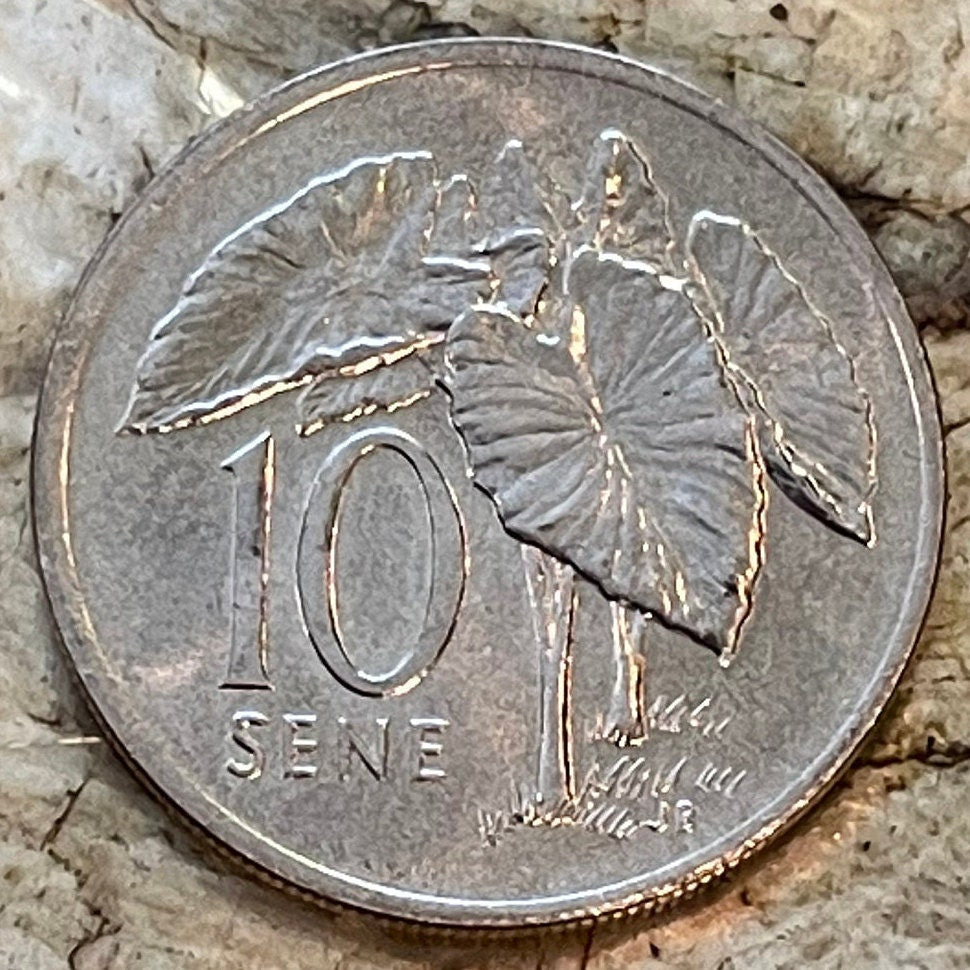elemintalshop
Taro Plant & President-for-Life Malietoa Tanumafili II 10 Sene Samoa Authentic Coin Money for Jewelry and Craft Making
Taro Plant & President-for-Life Malietoa Tanumafili II 10 Sene Samoa Authentic Coin Money for Jewelry and Craft Making
Couldn't load pickup availability
Taro Plant & President-for-Life Malietoa Tanumafili II 10 Sene Samoa Authentic Coin Money for Jewelry and Craft Making
Reverse: Taro plant (binomial name: Colocasia esculenta).
Lettering: 10 SENE
Obverse: Portrait of King Malietoa Tanumafili II
Lettering: MALIETOA TANUMAFILI II
SAMOA I SISIFO
Translation: Malietoa Tanumafili II (Malietoa means Chief)
Western Samoa
[Officially, this nation is now called the "Independent State of Samoa", and until 1997 was known as "Western Samoa".]
Edge: Reeded
Features
Issuer Samoa
Ruling authority Malietoa Tanumafili II (1962-2007)
Type Standard circulation coin
Years 1974-2000
Value 10 Sene (0.1 WST)
Currency Tala (1967-date)
Composition Copper-nickel
Weight 5.65 g
Diameter 23.6 mm
Shape Round
Technique Milled
Orientation Medal alignment ↑↑
Demonetized Yes
Number N# 3693
References KM# 15, Schön# 15
Wikipedia:
Colocasia esculenta is a tropical plant grown primarily for its edible corms, a root vegetable most commonly known as taro (/ˈtɑːroʊ, ˈtæroʊ/), kalo or godere. It is the most widely cultivated species of several plants in the family Araceae that are used as vegetables for their corms, leaves, and petioles. Taro corms are a food staple in African, Oceanic, and South Asian cultures (similar to yams), and taro is believed to have been one of the earliest cultivated plants.
The English term taro was borrowed from the Maori language of New Zealand when Captain Cook first observed plantations of Colocasia tubers there in 1769. The form taro or talo is widespread among Polynesian languages: taro in Tahitian; talo in Samoan; kalo in Hawaiian; taʻo in Marquesan. All these forms originate from Proto-Polynesian *talo, which itself descended from Proto-Oceanic *talos (cf. dalo in Fijian) and Proto-Austronesian *tales (cf. tales in Javanese). However, irregularity in sound correspondences among the cognate forms in Austronesian suggests that the term may have been borrowed from an Austroasiatic language perhaps somewhere in Borneo and spread from there (cf. proto-Mon-Khmer *t2rawʔ, Khasi shriew, Khmu sroʔ).
Colocasia esculenta has other names in different languages.
In the Philippines, the plant is known as gabi in Tagalog, aba in the Ilocos Region, and natong and apay in the Bicol Region.[citation needed] In India, it is called arvī (अरबी) in Hindi, kesave (ಕೇಸವೆ) in Kannada, alu (आळू) in Marathi, chempu (சேம்பு) in Tamil, chama (చామ) in Telugu, yendem (ꯌꯦꯟꯗꯦꯝ) in Meitei, venti (वेंटी) in Konkani, chēmbŭ (ചേമ്പ്) in Malayalam, and kochu (কচু) in Bangla. It is 芋 (yu) or 芋頭 (yu tou) in Chinese; 芋 (POJ: ō͘) or 芋頭 (ō͘-á) in Taiwanese Hokkien; and vasa in Paiwan,[8] and tali in Amis.
Names in African languages include jimbi in Swahili, amadumbe or madumbi in some languages of South Africa,[clarification needed] kontomire in Ghana, kókó and lámbó in Yoruba,[citation needed] and amateke in Kinyarwanda.[citation needed] It is dasheen in Trinidad and Tobago, Saint Lucia and Jamaica.
In Portuguese, it is known as inhame; and in Spanish it is called malanga. In the Sinhala language of Sri Lanka it is called "Kiri Ala" (කිරිඅල).
The Ancient Greek word κολοκάσιον (kolokasion, lit. 'lotus root') is the origin of the Modern Greek word kolokasi (κολοκάσι), the word kolokas in both Greek and Turkish, and kolkas (قلقاس) in Arabic. It was borrowed in Latin as colocasia, hence the genus name Colocasia.
Taro is among the most widely grown species in the group of tropical perennial plants that are referred to as "elephant ears" when grown as ornamental plants.
*****
WIkipedia:
Malietoa Tanumafili II GCMG CBE (4 January 1913 – 11 May 2007), addressed Susuga Malietoa Tanumafili II, was the Malietoa, the title of one of Samoa's four paramount chiefs, and the head of state, or O le Ao o le Malo, a position that he held for life, of Samoa from 1962 to 2007. He was co-head of state in 1962 with the tama-a-'aiga Tupua Tamasese Mea'ole and became the sole head of state on 15 April 1963 upon the death of his counterpart. At the time of his death, he was the oldest national leader in the world, and was also the last incumbent president-for-life in the world.
The Malietoa is one of the four tama-a-'aiga (maximal lineage) titles of Samoa, alongside Tupua Tamasese, Mata-afa and Tuimalealiifano.
Following an extended period deliberation, the Malietoa title passed to his eldest son, Malietoa Fa’amausili Molī.
******
Wikipedia:
Samoa, officially the Independent State of Samoa and until 1997 known as Western Samoa, is a Polynesian island country consisting of two main islands (Savai'i and Upolu), two smaller, inhabited islands (Manono and Apolima), and several smaller, uninhabited islands, including the Aleipata Islands (Nu'utele, Nu'ulua, Fanuatapu and Namua). Samoa is located 64 km (40 mi) west of American Samoa, 889 km (552 mi) northeast of Tonga (closest foreign country), 1,152 km (716 mi) northeast of Fiji, 483 km (300 mi) east of Wallis and Futuna, 1,151 km (715 mi) southeast of Tuvalu, 519 km (322 mi) south of Tokelau, 4,190 km (2,600 mi) southwest of Hawaii, and 610 km (380 mi)northwest of Niue. The capital city is Apia. The Lapita people discovered and settled the Samoan Islands around 3,500 years ago. They developed a Samoan language and Samoan cultural identity.
Samoa is a unitary parliamentary democracy with 11 administrative divisions. The sovereign state is a member of the Commonwealth of Nations. Western Samoa was admitted to the United Nations on 15 December 1976. Because of the Samoans' seafaring skills, pre-20th-century European explorers referred to the entire island group (which includes American Samoa) as the "Navigator Islands". The country was a colony of the German Empire from 1899 to 1915, then came under a joint British and New Zealand colonial administration until 1 January 1962, when it became independent.
Share










High quality coins nice price.
Thank you and very much









